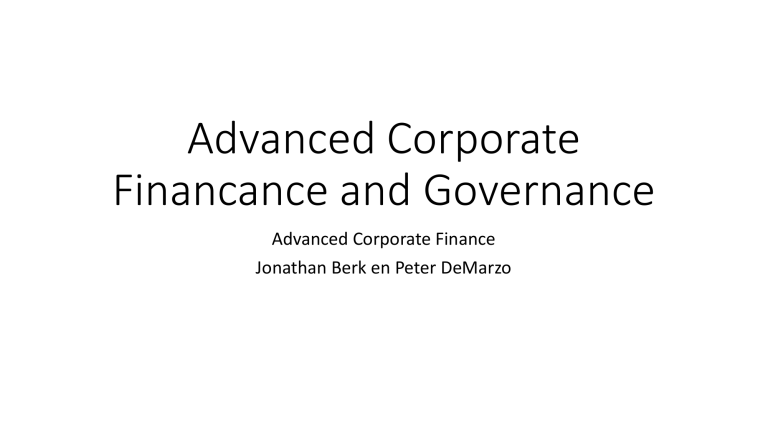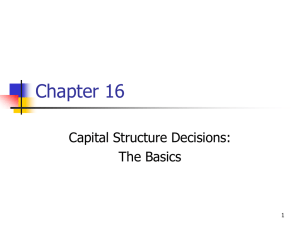Slides col 2. 21jan2019
advertisement

Advanced Corporate Financance and Governance Advanced Corporate Finance Jonathan Berk en Peter DeMarzo Advanced Corporate Finance Part 5 Optimal Capital Structure Hoofdstuk 15 Debt and Taxes Hoofdstuk 15 Debt and Taxes • 15.0 Introduction • 15.1 The Interest Tax Deduction • 15.2 Valuing the Interest Tax Shield • 15.3 Recapitalizing to Capture the Tax Shield • 15.4 Personal Taxes • 15.5 Optimal Capital Structure with Taxes Introduction • As Modigliani and Miller made clear in their original work, capital structure does not matter in perfect capital markets. • A perfect capital market exists under the following assumptions: 1. Investors and firms can trade the same set of securities at competitive market prices equal to the present value of their future cash flows 2. There are no taxes, transaction costs, or issuance costs associated with security trading. 3. A firm’s financing decisions do not change the cash flows generated by its investments, nor do they reveal new information about them. • Thus, if capital structure does matter, then it must stem from a market imperfection. • We focus on one such imperfection—taxes. 15.1 The Interest Tax Deduction Because a corporation does not owe taxes on the earnings it used to make interest payments, this is shielded from the corporate tax, providing the tax savings of the marginal corporate tax rate (Ꚍc) x Interestpayment. 15.1 The Interest Tax Deduction • The gain to investors from the tax deductibility of interest payments is referred to as the interest tax shield. • The interest tax shield is the additional amount that a firm would have paid in taxes if it did not have leverage. • The interest tax shield each year : 15.2 Valuing the Interest Tax Shield • The interest tax shield provides a corporate tax benefit each year. • The benefit of leverage for the value of the firm, is the present value of the stream of future interest tax shields the firm will receive. • Each year a firm makes interest payments, the cash flows it pays to investors will be higher than they would be without leverage by the amount of the interest tax shield. 15.2 Valuing the Interest Tax Shield • Thus, letting VL and VU represent the value of the firm with and without leverage, respectively, we have the following change to MM Proposition I in the presence of taxes: • The total value of the levered firm exceeds the value of the firm without leverage due to the present value of the tax savings from debt: 15.2 Valuing the Interest Tax Shield • As long as the debt is fairly priced, no arbitrage implies that its market value must equal the present value of the future interest payments: • If the firma marginal tax rate, Ꚍc is constant the following general formula is: 15.2 Valuing the Interest Tax Shield • The Weighted Average Cost of Capital with Taxes • We can account for the benefit of the interest tax shield by calculating the WACC using the effective after-tax cost of debt: • The WACC represents the effective cost of capital to the firm, after including the benefits of the interest tax shield. It is therefore lower than the pretax WACC, which is the average return paid to the firm’s investors. 15.2 Valuing the Interest Tax Shield • From Eq. 15.5, we have the following relationship between the WACC and the firm’s pretax WACC: 15.3 Recapitalizing to Capture the Tax Shield When a firm makes a significant change to its capital structure, the transaction is called a recapitalization (or simply a “recap”). A leveraged recapitalization: a firm issues a large amount of debt and uses the proceeds to pay a special dividend or to repurchase shares. 1. When securities are fairly priced, the original shareholders of a firm capture the full benefit of the interest tax shield from an increase in leverage. 2. This increase in the share price is due solely to the present value of the (anticipated) interest tax shield. 3. Thus, even though leverage reduces the total value of equity, shareholders capture the benefits of the interest tax shield upfront. 15.4 Personal Taxes • Unfortunately for investors, after they receive the cash flows, they are generally taxed again. 1. For individuals, interest payments received from debt are taxed as income. 2. Equity investors also must pay taxes on dividends and capital gains. What are the consequences to firm value of these additional taxes? • Personal taxes have the potential to offset some of the corporate tax benefits of leverage that we have described. • In particular, in the United States and many other countries, interest income has historically been taxed more heavily than capital gains from equity. • To determine the true tax benefit of leverage, we need to evaluate the combined effect of both corporate and personal taxes. 15.4 Personal Taxes • Thus, just like corporate taxes, personal taxes reduce the cash flows to investors and diminish firm value. • As a result, the actual interest tax shield depends on the reduction in the total taxes (both corporate and personal) that are paid. 15.4 Personal Taxess 15.4 Personal Taxes • Consider a firm with $1 of earnings before interest and taxes. • Combining corporate and personal rates leads to the following comparison: • While a tax advantage to debt remains, it is not as large as we calculated based on corporate taxes alone. • Personal taxes reduce the tax advantage of debt from Ꚍc toꚌ*. 15.4 Personal Taxes • To express the comparison in relative terms, note that equity holders receive Ꚍ* less after taxes than debtholders. • In general, every $1 received after taxes by debt holders from interest payments costs equity holders $(1 - Ꚍ*) on an after-tax basis. 15.4 Personal Taxes • How does personal taxes affect our valuation of the debt tax shield? • First, as long as Ꚍ* > 0, then despite any tax disadvantage of debt at the personal level, a net tax advantage for leverage remains. • In the case of permanent debt, the value of the firm with leverage becomes : 15.5 Optimal Capital Structure with Taxes • The optimal level of leverage from a tax-saving perspective is the level such that interest equals EBIT. • In this case, the firm takes full advantage of the corporate tax deduction of interest, but avoids the tax disadvantage of excess leverage at the personal level. • The optimal fraction of debt, as a proportion of a firm’s capital structure [D/(E + D)], declines with the growth rate of the firm. • The value of the firm’s equity will depend on the growth rate of earnings: The higher the growth rate, the higher the value of equity is (and equivalently, the higher the firm’s price-earnings multiple is). Samenvatting • Thus, if capital structure does matter, then it must stem from a market imperfection. • In this chapter, we focused on one such imperfection—taxes. • Corporations and investors must pay taxes on the income they earn from their investments. • As we have seen, a firm can enhance its value by using leverage to minimize the taxes it, and its investors, pay. Advanced Corporate Finance Hoofdstuk 16 Financial Distress, Managerial Incentives, and Information Hoofdstuk 16 Financial Distress, Managerial Incentives, and Information Opbouw • 16.1 Default and Bankruptcy in a Perfect Market • 16.2 The Costs of Bankruptcy and Financial Distress • 16.3 Financial Distress Costs and Firm Value • 16.4 Optimal Capital Structure: The Trade-Off Theory • 16.5 Exploiting Debt Holders: The Agency Costs of Leverage • 16.6 Motivating Managers: The Agency Benefits of Leverage • 16.7 Agency Costs and the Trade-Off Theory 16.1 Default and Bankruptcy in a Perfect Market • In the Modigliani-Miller setting, leverage may result in bankruptcy, but bankruptcy alone does not reduce the value of the firm. • With perfect capital markets, bankruptcy shifts ownership from the equity holders to debt holders without changing the total value available to all investors. 16.2 The Costs of Bankruptcy and Financial Distress • Bankruptcy is a costly process that imposes both direct and indirect costs on a firm and its investors. • Direct costs: include the costs of experts and advisors such as lawyers, accountants etc. • Indirect costs include the loss of customers, suppliers, employees, or receivables during bankruptcy and selling assets at distressed prices. 16.3 Financial Distress Costs and Firm Value • Financial distress means that a firm has trouble meeting its debt obligations. • The costs of financial distress represent an important departure from Modigliani and Miller’s assumption of perfect capital markets. • MM assumed that the cash flows of a firm’s assets do not depend on its choice of capital structure. • As we have discussed, however, levered firms risk incurring financial distress costs that reduce the cash flows available to investors. 16.4 Optimal Capital Structure: The Trade-Off Theory • The trade-off theory weighs the benefits of debt that result from shielding cash flows from taxes against the costs of financial distress associated with leverage. • According to this theory, the total value of a levered firm equals the value of the firm without leverage plus the present value of the tax savings from debt, less the present value of financial distress costs: 16.5 Exploiting Debt Holders: The Agency Costs of Leverage A highly levered firm with risky debt faces the following agency costs: 1. Asset substitution: Shareholders can gain by making negative-NPV investments or decisions that sufficiently increase the firm’s risk. Because leverage gives shareholders an incentive to replace low-risk assets with riskier ones, this result is often referred to as the asset substitution problem 2. Debt overhang: Shareholders may be unwilling to finance new, positive-NPV projects. Because the debt holders receive most of the benefit, this project is a negative-NPV investment opportunity for equity holders, even though it offers a positive NPV for the firm. 3. Cashing out: Shareholders have an incentive to liquidate assets at prices below their market values and distribute the proceeds as a dividend. 16.6 Motivating Managers: The Agency Benefits of Leverage Leverage has agency benefits and can improve incentives for managers to run a firm more efficiently and effectively due to Increased ownership concentration. 1. Managers with higher ownership concentration are more likely to work hard and less likely to consume corporate perks. 2. Reduced free cash flow: Firms with less free cash flow are less likely to pursue wasteful investments. 3. Reduced managerial entrenchment and Increased commitment: The threat of financial distress and being fired may commit managers more fully to pursue strategies that improve operations. 16.7 Agency Costs and the Trade-Off Theory • We can extend the trade-off theory to include agency costs. The value of a firm, including agency costs and benefits, is: • Note that the relative magnitudes of the different costs and benefits of debt vary with the characteristics of the firm. • Likewise, the optimal level of debt varies. Samenvatting • In this chapter, we considered how a firm’s choice of capital structure can, due to market imperfections, affect its costs of financial distress, alter managers’ incentives, and signal information to investors. • Each of these consequences of the capital structure decision can be significant, and each may offset the tax benefits of leverage when leverage is high.



